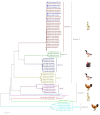Insight into the Epidemiology and Evolutionary History of Novel Goose Astrovirus-Associated Gout in Goslings in Southern China
- PMID: 35746777
- PMCID: PMC9230684
- DOI: 10.3390/v14061306
Insight into the Epidemiology and Evolutionary History of Novel Goose Astrovirus-Associated Gout in Goslings in Southern China
Abstract
A novel gout disease, characterized by visceral urate deposition with high-mortality, with outbreaks in goslings in China since 2016 was caused by a novel goose astrovirus (GoAstV) and resulted in serious economic loss. However, the epidemiology and variation of the GoAstV in goslings in southern China and its evolutionary history as well as the classification of the GoAstV are unclear. In the present study, systematic molecular epidemiology, and phylogenetic analyses of the GoAstV were conducted to address these issues. Our results showed that the GoAstV is widespread in goslings in southern China, and the genomes of six GoAstV strains were obtained. Two amino acid mutations (Y36H and E456D) were identified in capsid proteins in this study, which is the dominant antigen for the GoAstV. In addition, the GoAstV could be divided into two distinct clades, GoAstV-1 and GoAstV-2, and GoAstV-2 is responsible for gout outbreaks in goslings and could be classified into Avastrovirus 3 (AAstV-3), while GoAstV-1 belongs to Avastrovirus 1 (AAstV-1). Moreover, the emergence of GoAstV-2 in geese was estimated to have occurred in January 2010, approximately 12 years ago, while GoAstV-1 emerged earlier than GoAstV-2 and was estimated to have emerged in April 1985 based on Bayesian analysis. The mean evolutionary rate for the GoAstV was also calculated to be approximately 1.42 × 10-3 nucleotide substitutions per site per year. In conclusion, this study provides insight into the epidemiology of the GoAstV in goslings in southern China and is helpful for understanding the origin and evolutionary history as well as the classification of the GoAstV in geese.
Keywords: GoAstV; evolutionary history; gout; molecular epidemiology.
Conflict of interest statement
The authors declare that they have no conflict of interest.
Figures




Similar articles
-
Isolation and phylogenetic analysis of goose astrovirus type 1 from goslings with gout in Jiangxi province, China.Poult Sci. 2022 Jul;101(7):101800. doi: 10.1016/j.psj.2022.101800. Epub 2022 Feb 23. Poult Sci. 2022. PMID: 35580375 Free PMC article.
-
Isolation and characterization of goose astrovirus genotype 1 causing enteritis in goslings from Sichuan Province, China.BMC Vet Res. 2025 Apr 9;21(1):259. doi: 10.1186/s12917-025-04482-9. BMC Vet Res. 2025. PMID: 40205381 Free PMC article.
-
Isolation and evolutionary analyses of gout-associated goose astrovirus causing disease in experimentally infected chickens.Poult Sci. 2021 Feb;100(2):543-552. doi: 10.1016/j.psj.2020.11.003. Epub 2020 Nov 18. Poult Sci. 2021. PMID: 33518107 Free PMC article.
-
Goose Astrovirus in China: A Comprehensive Review.Viruses. 2022 Aug 12;14(8):1759. doi: 10.3390/v14081759. Viruses. 2022. PMID: 36016381 Free PMC article. Review.
-
A Review of the Emerging Poultry Visceral Gout Disease Linked to Avian Astrovirus Infection.Int J Mol Sci. 2022 Sep 9;23(18):10429. doi: 10.3390/ijms231810429. Int J Mol Sci. 2022. PMID: 36142340 Free PMC article. Review.
Cited by
-
Molecular characterization of a virulent goose astrovirus genotype-2 with high mortality in vitro and in vivo.Poult Sci. 2024 May;103(5):103585. doi: 10.1016/j.psj.2024.103585. Epub 2024 Feb 28. Poult Sci. 2024. PMID: 38492247 Free PMC article.
-
Comparative transcriptomic analysis of goose astrovirus genotype 1 and 2 in goose embryonic fibroblasts.Poult Sci. 2024 Dec;103(12):104347. doi: 10.1016/j.psj.2024.104347. Epub 2024 Sep 18. Poult Sci. 2024. PMID: 39357233 Free PMC article.
-
Rapid detection of avipoxvirus using a fluorescent probe-based multienzyme isothermal amplification assay.Front Vet Sci. 2025 May 14;12:1601685. doi: 10.3389/fvets.2025.1601685. eCollection 2025. Front Vet Sci. 2025. PMID: 40438408 Free PMC article.
-
Infection and innate immune mechanism of goose astrovirus.Front Microbiol. 2023 Jan 26;14:1121763. doi: 10.3389/fmicb.2023.1121763. eCollection 2023. Front Microbiol. 2023. PMID: 36778860 Free PMC article. Review.
-
Surveillance, Prevention, Evolution and Control of Emerging Viruses: A 2022 Editorial Update.Viruses. 2023 Oct 17;15(10):2098. doi: 10.3390/v15102098. Viruses. 2023. PMID: 37896875 Free PMC article.
References
Publication types
MeSH terms
LinkOut - more resources
Full Text Sources
Medical
Miscellaneous

